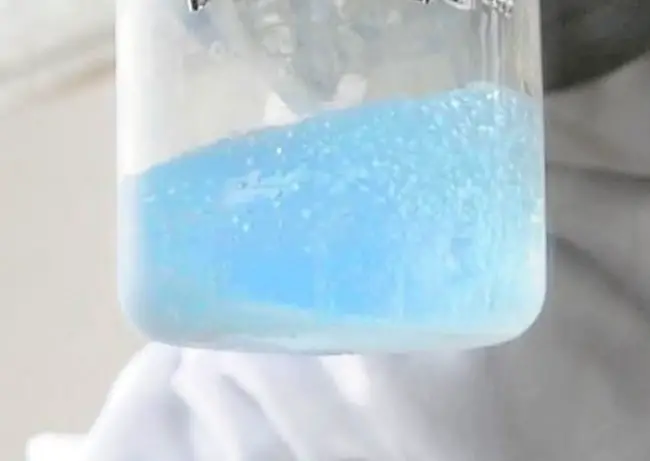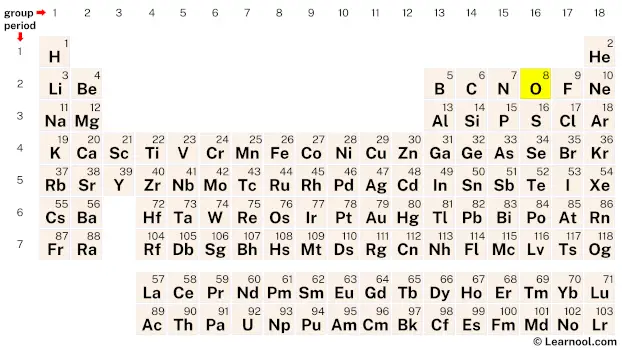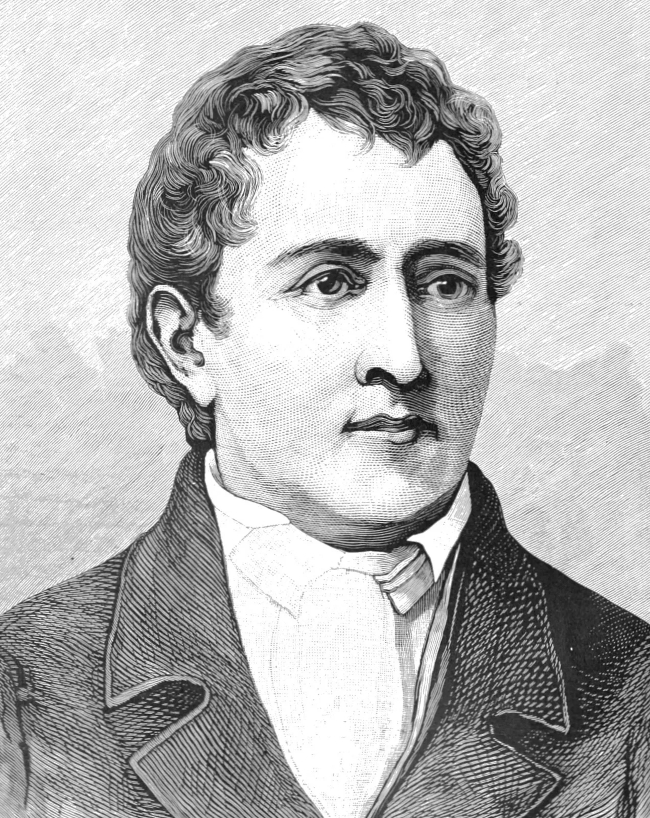
Oxygen (O) is a chemical element of the periodic table, located in the group 16 and the period 2, and is having the atomic number 8. It is a colorless, odorless, tasteless gas, whose name comes from the Greek word “oxy genes”, which means acid forming. It is a reactive nonmetal and is the first most abundant element on earth. It is the first element in the chalcogen group.
On periodic table
| group | ⇨ | 1 | 2 | 3 | 4 | 5 | 6 | 7 | 8 | 9 | 10 | 11 | 12 | 13 | 14 | 15 | 16 | 17 | 18 |
| period | ⇩ | ||||||||||||||||||
| 1 | 1 H  Hydrogen |
2 He  Helium |
|||||||||||||||||
| 2 | 3 Li  Lithium |
4 Be  Beryllium |
5 B  Boron |
6 C  Carbon |
7 N  Nitrogen |
8 O Oxygen |
9 F  Fluorine |
10 Ne  Neon |
|||||||||||
| 3 | 11 Na  Sodium |
12 Mg  Magnesium |
13 Al  Aluminium |
14 Si Silicon |
15 P  Phosphorus |
16 S  Sulfur |
17 Cl  Chlorine |
18 Ar  Argon |
|||||||||||
| 4 | 19 K  Potassium |
20 Ca  Calcium |
21 Sc  Scandium |
22 Ti  Titanium |
23 V  Vanadium |
24 Cr  Chromium |
25 Mn  Manganese |
26 Fe  Iron |
27 Co  Cobalt |
28 Ni  Nickel |
29 Cu  Copper |
30 Zn  Zinc |
31 Ga  Gallium |
32 Ge  Germanium |
33 As  Arsenic |
34 Se  Selenium |
35 Br  Bromine |
36 Kr  Krypton |
|
| 5 | 37 Rb  Rubidium |
38 Sr  Strontium |
39 Y  Yttrium |
40 Zr  Zirconium |
41 Nb  Niobium |
42 Mo  Molybdenum |
43 Tc  Technetium |
44 Ru  Ruthenium |
45 Rh  Rhodium |
46 Pd  Palladium |
47 Ag  Silver |
48 Cd  Cadmium |
49 In  Indium |
50 Sn  Tin |
51 Sb  Antimony |
52 Te  Tellurium |
53 I  Iodine |
54 Xe  Xenon |
|
| 6 | 55 Cs  Caesium |
56 Ba  Barium |
72 Hf  Hafnium |
73 Ta  Tantalum |
74 W  Tungsten |
75 Re  Rhenium |
76 Os  Osmium |
77 Ir  Iridium |
78 Pt  Platinum |
79 Au  Gold |
80 Hg  Mercury |
81 Tl  Thallium |
82 Pb  Lead |
83 Bi  Bismuth |
84 Po  Polonium |
85 At  Astatine |
86 Rn  Radon |
||
| 7 | 87 Fr  Francium |
88 Ra  Radium |
104 Rf  Rutherfordium |
105 Db  Dubnium |
106 Sg  Seaborgium |
107 Bh  Bohrium |
108 Hs  Hassium |
109 Mt  Meitnerium |
110 Ds  Darmstadtium |
111 Rg  Roentgenium |
112 Cn  Copernicium |
113 Nh  Nihonium |
114 Fl  Flerovium |
115 Mc  Moscovium |
116 Lv  Livermorium |
117 Ts  Tennessine |
118 Og  Oganesson |
||
| 57 La  Lanthanum |
58 Ce  Cerium |
59 Pr  Praseodymium |
60 Nd  Neodymium |
61 Pm  Promethium |
62 Sm  Samarium |
63 Eu  Europium |
64 Gd  Gadolinium |
65 Tb  Terbium |
66 Dy  Dysprosium |
67 Ho  Holmium |
68 Er  Erbium |
69 Tm  Thulium |
70 Yb  Ytterbium |
71 Lu  Lutetium |
|||||
| 89 Ac  Actinium |
90 Th  Thorium |
91 Pa  Protactinium |
92 U  Uranium |
93 Np  Neptunium |
94 Pu  Plutonium |
95 Am  Americium |
96 Cm  Curium |
97 Bk  Berkelium |
98 Cf  Californium |
99 Es  Einsteinium |
100 Fm  Fermium |
101 Md  Mendelevium |
102 No  Nobelium |
103 Lr  Lawrencium |
|||||
| – p block |
Oxygen is a p-block element, found in the sixteenth column (oxygen group) and the second row of the periodic table. It has the atomic number 8 and is denoted by the symbol O.
Element information
 |
|
 |
|
| Origin of name | Greek word “oxy genes” (which means acid forming) |
| Symbol | O |
| Atomic number (Z) | 8 |
| Atomic mass | 15.999 u |
| Block | p-block |
| Group | 16 (oxygen group) |
| Period | 2 |
| Classification | Reactive nonmetal |
| Covalent radius | 66±2 pm |
| Van der Waals radius | 152 pm |
| Melting point | -218.79 ℃, -361.82 ℉, 54.36 K |
| Boiling point | -182.962 ℃, -297.332 ℉, 90.188 K |
| Electron configuration | [He] 2s2 2p4 |
| Electrons per shell | 2, 6 |
| Learn how to draw: Oxygen Bohr model | |
| Crystal structure | Cubic |
| Phase at r.t | Gas |
| Density near r.t | 1.429 g/L |
| Main isotopes | Oxygen-16, Oxygen-17, Oxygen-18 |
| Natural occurrence | Primordial |
| Oxidation state | -2 |
| Electronegativity (Pauling scale) | 3.44 |
| Protons Neutrons Electrons |
8 8 8 |
| Learn how to find: Oxygen protons neutrons electrons | |
| Valence electrons | 6 |
| Learn how to find: Oxygen valence electrons | |
| CAS number | 7782-44-7 |
| Discovered by | Carl Wilhelm Scheele in 1772 |
History

Oxygen has a long and interesting history, with the earliest known discovery of its existence dating back to the 16th century. However, the discovery of its properties and the role it plays in supporting life on Earth came much later.
The first recorded discovery of oxygen was by the Swedish chemist Carl Wilhelm Scheele in 1772. Scheele observed that when certain compounds were heated, they released a gas that enhanced combustion, and he named this gas “fire air.” The English chemist Joseph Priestley also independently discovered oxygen in 1774, but he referred to it as “dephlogisticated air.”
The French chemist Antoine Lavoisier is credited with giving oxygen its name in the late 18th century. Lavoisier recognized oxygen as a key component of air and demonstrated that it was necessary for combustion and respiration. He also proposed the law of conservation of mass and established the concept of chemical elements.
Oxygen has played a crucial role in the development of chemistry and modern science, and its discovery and properties have been studied extensively over the past few centuries. Today, oxygen is widely used in a range of industries, including medicine, aviation, and metallurgy, and it continues to be an important subject of study in the field of chemistry.
Occurrence
Oxygen is one of the most abundant elements in the Earth’s crust, accounting for about 47% of the total mass of the Earth’s crust. It is also a major component of the Earth’s atmosphere, making up about 21% of the air we breathe. Oxygen is found in a wide range of minerals and compounds, including oxides, carbonates, sulfates, and silicates. The most common oxide of oxygen is silica (SiO2), which is found in many types of rocks, including granite, sandstone, and quartz. Oxygen is also found in water molecules (H2O) and organic molecules such as proteins, carbohydrates, and fats.
Production
Oxygen is produced by a variety of natural and artificial processes. One of the most significant natural sources of oxygen is photosynthesis, the process by which green plants, algae, and some bacteria convert sunlight into chemical energy, producing oxygen as a byproduct. Another natural source of oxygen is the Earth’s atmosphere, which is constantly being replenished by the photosynthetic activity of plants and other organisms.
Artificially, oxygen is produced through several methods, including the electrolysis of water, the distillation of air, and the decomposition of certain compounds, such as hydrogen peroxide. The electrolysis of water involves passing an electric current through water to break it down into hydrogen and oxygen gas. Distillation of air involves cooling and compressing air to produce liquid oxygen, which can then be separated from other gases using distillation methods. Oxygen can also be produced by heating certain compounds, such as potassium chlorate, which decomposes to form oxygen gas.
The industrial production of oxygen is typically done through the distillation of air, as it is a more efficient and cost-effective method. The distillation process involves cooling and compressing air to produce liquid oxygen, which is then stored and transported for various industrial applications, including welding, metal cutting, and medical use. The production of oxygen is a critical component of many industries, including aerospace, healthcare, and manufacturing.
Properties
Physical properties
Oxygen is a colorless, odorless, and tasteless gas.
It is slightly soluble in water and highly soluble in organic solvents.
Oxygen gas is slightly heavier than air, with a density of 1.429 g/L at standard temperature and pressure (STP).
Chemical properties
Oxygen is highly reactive and can combine with most elements to form oxides.
It is a powerful oxidizing agent and supports combustion.
Oxygen gas is paramagnetic, which means that it is attracted to magnetic fields.
Biological properties
Oxygen is essential for most living organisms to carry out cellular respiration and produce energy.
However, oxygen can also be toxic to organisms at high concentrations, causing oxidative stress and damage to cells.
Other properties
Oxygen has three isotopes: oxygen-16, oxygen-17, and oxygen-18, with oxygen-16 being the most abundant (99.76% natural abundance).
Liquid oxygen is used as an oxidizer in rocket propellants and medical therapies, and as a coolant in industrial processes.
Applications
Life support
Oxygen is vital for the survival of living organisms, including humans. It is used in medical settings to support patients with breathing difficulties or during surgical procedures.
Combustion
Oxygen is used to support combustion in various applications, such as in the production of steel, glass, and other materials. It is also used in the burning of fuels for transportation and energy production.
Water treatment
Oxygen is used in water treatment processes to increase the amount of dissolved oxygen in water, which is necessary for aquatic life to survive.
Ozone generation
Oxygen can be used to generate ozone, which is used in various applications such as water purification, odor control, and sterilization.
Welding and cutting
Oxygen is used as an oxidizing agent in welding and cutting processes to increase the temperature of the flame and improve the efficiency of the process.
Chemical synthesis
Oxygen is used in chemical synthesis processes, such as in the production of nitric acid, sulfuric acid, and other chemicals.
Aerospace
Oxygen is used in the aerospace industry as a component of rocket propellants and as an oxidizer in combustion reactions.
Food preservation
Oxygen is used in the preservation of foods to inhibit the growth of bacteria and other microorganisms.
Bleaching
Oxygen is used as a bleaching agent in the textile, pulp and paper, and other industries.
Interesting facts
Oxygen gas was discovered independently by Carl Wilhelm Scheele in Sweden in 1772 and Joseph Priestley in England in 1774.
The name “oxygen” comes from the Greek words “oxys” and “gennan,” which together mean “acid-forming.” This name was given to the element because of its ability to form acids.
Oxygen is the third most abundant element in the universe after hydrogen and helium.
Oxygen makes up about 21% of the Earth’s atmosphere by volume.
Oxygen is essential for life and is used by almost all living organisms in the process of respiration.
Liquid oxygen is used as a rocket propellant.
Oxygen is used in the production of steel, plastics, and textiles.
Ozone (O3), a form of oxygen, protects Earth from harmful ultraviolet radiation from the sun.
Oxygen is a highly reactive element and is capable of combining with almost all other elements to form compounds.
Oxygen gas has no color, taste, or odor.
Related
More elements
External links
- https://www.rsc.org/periodic-table/element/8/oxygen
- https://www.britannica.com/science/oxygen
- https://pubchem.ncbi.nlm.nih.gov/element/Oxygen
- https://en.wikipedia.org/wiki/Oxygen
- https://education.jlab.org/itselemental/ele008.html
- https://chemistrytalk.org/oxygen-element/
- https://www.ducksters.com/science/chemistry/oxygen.php
- https://www.chemistrylearner.com/oxygen.html
Deep
Learnool.com was founded by Deep Rana, who is a mechanical engineer by profession and a blogger by passion. He has a good conceptual knowledge on different educational topics and he provides the same on this website. He loves to learn something new everyday and believes that the best utilization of free time is developing a new skill.
